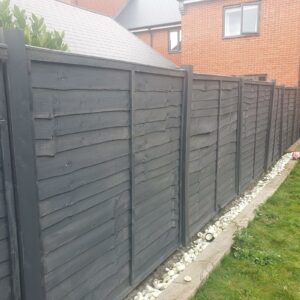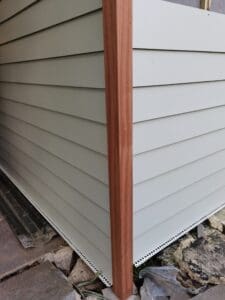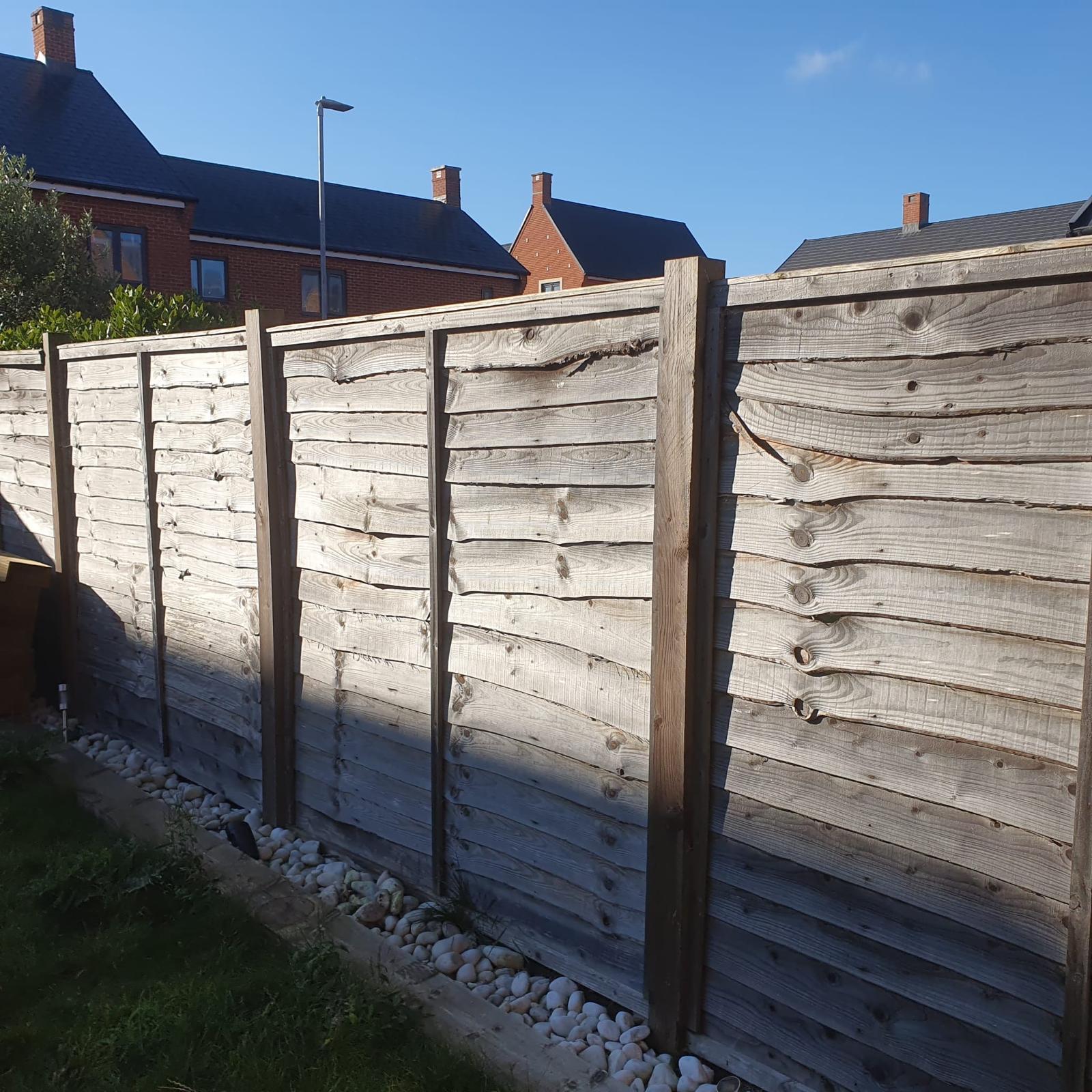Painting your fence in Essex can really change the look of your garden. It might seem like a big job, but with a bit of planning, you can do it yourself. Choosing the right paint and tools is key. Whether you’re doing it yourself or hiring someone, knowing the basics helps. Here’s a simple guide to get you started.
Key Takeaways
- Pick the right paint for your fence to ensure it lasts through Essex’s weather.
- Prepare your fence properly by cleaning and sanding for a smooth finish.
- Use the right tools like brushes, rollers, or sprayers for even coverage.
- Consider adding a protective coating to extend the life of your paint job.
- Decide if you want to DIY or hire a professional based on your skills and budget.
Choosing the Right Paint for Your Essex Fence
Understanding Paint Types and Their Benefits
When it comes to painting your fence, the type of paint you choose can make a world of difference. Oil-based paints, for instance, are known for their durability and ability to withstand harsh weather conditions, making them a popular choice for outdoor projects. On the other hand, water-based paints dry faster and are easier to clean up, but they might not last as long under constant exposure to the elements. In Essex, where the weather can be unpredictable, it’s crucial to select a paint that can handle both sun and rain.
Selecting Colours to Complement Your Garden
Choosing the right colour for your fence can transform your garden from ordinary to extraordinary. We recommend considering the existing elements in your garden. For instance, if you have a lot of greenery, a dark green or earthy brown can blend seamlessly with the natural surroundings. Alternatively, a soft grey or blue can create a calming backdrop that makes plants pop. Remember, bold colours can make small gardens appear larger by pushing boundaries visually.
Weather Considerations for Paint Longevity
The weather in Essex can be quite the rollercoaster, impacting how well your paint job holds up. To ensure longevity, it’s best to paint during a dry spell, ideally in late spring or early autumn. This gives the paint ample time to dry and cure without the threat of rain or extreme heat. Additionally, opting for paints with UV protection can help prevent fading and maintain vibrancy through sunny seasons. A good rule of thumb is to always check the forecast before starting your painting project.
Preparing Your Fence for a Flawless Finish
Essential Tools and Materials for Preparation
Painting a fence isn’t just about slapping on a fresh coat of paint. Preparation is key to ensuring that your fence looks great and stands up to the elements. Here’s what you’ll need to get started:
- Safety goggles to protect your eyes
- A sturdy paint roller and brushes
- Sandpaper or a sander for smoothing surfaces
- A power washer or hose for cleaning
- Tarp to protect the ground
- Hammer and nails for repairs
Having these tools on hand will make the process smoother and help you achieve a professional finish.
Step-by-Step Guide to Cleaning and Sanding
Before we even think about painting, cleaning and sanding your fence is crucial. Follow these steps:
- Clear the Area: Remove any plants or decorations near the fence. Lay down a tarp to catch debris.
- Wash the Fence: Use a power washer to remove dirt, grime, and old paint. Let it dry completely.
- Inspect for Damage: Check for loose nails or broken panels. Repair these before moving on.
- Sand the Surface: Use sandpaper or a sander to smooth out rough spots and remove any remaining paint.
Proper prep work can make all the difference in how your fence turns out.
Repairing Damaged Panels and Sections
No one wants to paint over a damaged fence. It’s important to fix any issues before painting. Here’s how:
- Replace Loose Nails and Screws: Use rust-resistant nails or screws to secure loose parts.
- Patch Cracks and Holes: Fill any gaps with wood filler and sand smooth once dry.
- Reinforce Weak Areas: Add extra support to sections that seem wobbly or unstable.
Taking the time to do these repairs will ensure that your paint job lasts longer and looks better. Plus, it gives your fence that solid, sturdy feel that we all want in our outdoor spaces.
Mastering the Art of Fence Painting Techniques

Using Brushes, Rollers, and Sprayers Effectively
When it comes to painting fences, choosing the right tool can make all the difference. Brushes are ideal for detailed work and edges, while rollers cover large flat areas quickly. Sprayers, on the other hand, are perfect for an even coat but require practise to avoid overspray. Each tool has its unique strengths, and sometimes, using a combination is the best approach.
Achieving an Even Coat: Tips and Tricks
Getting an even coat is all about technique. Start by applying a primer to ensure the paint adheres well. When using a brush, dip it halfway into the paint and tap off the excess. For rollers, load it evenly and roll in a ‘W’ pattern for uniform coverage. If you’re using a sprayer, maintain a consistent distance from the fence and move in steady, horizontal lines. Remember, patience is key—multiple thin coats are better than one thick one.
Common Mistakes to Avoid During Application
Avoiding mistakes can save time and effort. One common error is painting in direct sunlight, which can cause the paint to dry too quickly and lead to streaks. Also, don’t rush the drying process between coats; it’s essential to let each layer dry completely before applying the next. Skipping surface preparation is another big no-no; always clean and sand your fence before painting to ensure the best finish.
Taking the time to master these techniques can transform your fence from a simple boundary to a standout feature in your garden.
Enhancing Durability with Protective Coatings
Importance of Primers and Sealants
When it comes to painting fences, primers and sealants are our best friends. They do more than just add an extra layer; they ensure the paint adheres properly and lasts longer. Think of primer as the handshake between your fence and the paint, making sure they get along just fine. We always go for a primer that’s suited to the material of our fence, whether it’s wood, metal, or something else. And let’s not forget sealants. They lock in the colour and protect against moisture, which is a big deal in a place like Essex where the weather can be quite unpredictable.
Applying UV and Weather-Resistant Finishes
In Essex, where the weather can swing from sunny to rainy in a heartbeat, using UV and weather-resistant finishes is crucial. These finishes act like a sunblock for your fence, protecting it from fading and peeling due to sun exposure. We often use finishes that are specifically designed to withstand the local climate, ensuring that our fences look fresh and vibrant for years. It’s about picking the right finish that can handle both the heat of summer and the dampness of winter.
Maintaining Your Fence Post-Painting
Once the paint job is done, the work isn’t over. Maintaining your fence post-painting is key to keeping it looking its best. We recommend checking for any chips or cracks regularly and touching them up as needed. It’s also a good idea to clean your fence occasionally to remove dirt and grime that can wear down the paint over time. A little maintenance goes a long way in preserving the beauty and durability of your fence.
Professional vs DIY: Making the Right Choice
Assessing the Complexity of Your Project
When it comes to painting your fence, the first step is to evaluate the complexity of the project. Some fences might just need a simple touch-up, while others could require a full overhaul. Consider factors like the size of your fence, the condition of the wood, and any intricate designs or patterns. If your fence is large or has special features, hiring a professional might be the best route. On the other hand, if it’s a straightforward job, a DIY approach can be both satisfying and cost-effective.
Cost Comparison: Hiring Experts vs Doing It Yourself
Let’s talk money. Painting a fence yourself is usually cheaper upfront because you’re not paying for labour. However, don’t forget the cost of materials, tools, and possibly renting equipment. Here’s a simple breakdown:
| Item | DIY Cost | Professional Cost |
|---|---|---|
| Paint and Materials | £50-£100 | Included |
| Tools (brushes, rollers) | £20-£50 | Included |
| Labour | Free | £150-£300 |
While DIY can save you a few quid, professionals often provide a warranty for their work, which can be worth the extra expense.
Time and Effort: What to Expect
Time is another big consideration. DIY painting can take a weekend or more, depending on your availability and the weather. You might enjoy the process, but it can also be tiring and time-consuming. Professionals, however, can usually complete the job in a day or two, thanks to their experience and efficiency.
Taking on a DIY fence painting project can be a rewarding experience, but it’s important to weigh the time and effort against the potential savings. If you have the time and energy, go for it! Otherwise, hiring a professional could be the way to go.
In the end, the choice between professional and DIY fence painting depends on your personal circumstances, including your budget, time, and the specific requirements of your project. Whether you decide to roll up your sleeves or call in the pros, make sure you plan carefully to achieve the best results.
Seasonal Tips for Fence Painting in Essex

Best Times of Year for Optimal Results
When it comes to painting fences in Essex, timing is everything. The ideal periods are during spring and summer when the weather is more predictable. Spring is particularly favourable as it offers mild temperatures and lower humidity, which help the paint adhere better and dry evenly. Summer, while warmer, is still a good option, provided you avoid the peak heat of the day which can cause the paint to dry too quickly and lead to cracking. Always check the weather forecast to ensure no rain is expected for at least 24 hours post-painting.
Dealing with Essex Weather Challenges
Essex weather can be a bit unpredictable, and that’s something we need to be prepared for. Sudden showers can ruin a fresh coat of paint, so having a backup plan is essential. Consider setting up a temporary shelter over the fence if rain is forecasted unexpectedly. Also, wind can be a nuisance, blowing dust onto your fresh paint or causing uneven drying. Try to paint on days with minimal wind to avoid these issues.
Preparing for Seasonal Changes
As the seasons change, so does the condition of your fence. In autumn, falling leaves and increased moisture can affect the paint’s longevity. We recommend a thorough cleaning in early spring to remove any winter grime and prepare the surface for a fresh coat. During winter, keep an eye out for any damage caused by frost or snow, and address these issues promptly. Regular maintenance will ensure your fence remains vibrant and protected throughout the year.
Creative Ideas to Transform Your Outdoor Space
Incorporating Patterns and Designs
When it comes to adding flair to your garden, patterns and designs can work wonders. A well-chosen pattern can turn a simple fence into a piece of art. Think about using stencils to create geometric shapes or nature-inspired motifs on your fence. If you’re feeling adventurous, try a mural that tells a story or reflects your personality. Patterns can also be subtle, like a two-tone diagonal stripe that adds depth without overwhelming the eye.
Using Paint to Create Garden Zones
Painting isn’t just for aesthetics; it’s a practical way to define spaces in your garden. Use different colours to mark out areas for dining, playing, or relaxing. For instance, a bright yellow can signal a lively play area, while a soft blue might denote a calming corner for reading. This technique helps in organising your outdoor space and making it more functional for various activities.
Colour Psychology in Outdoor Spaces
Colours have a profound impact on our mood and perception. In the garden, they can be used strategically to create the atmosphere you want. Warm colours like reds and oranges can make a space feel inviting and energetic, perfect for social areas. On the other hand, cool colours such as greens and blues are calming, ideal for meditation or relaxation spots. Consider what mood you want to evoke and choose your fence and garden colours accordingly.
Transforming your garden doesn’t have to be a massive overhaul. Sometimes, a few strategic paint choices can redefine your space, making it feel both new and uniquely yours.
Sustainability in Fence Painting
Eco-Friendly Paint Options
When we’re painting a fence, we often overlook the environmental impact of the materials we use. Choosing eco-friendly paints is a great way to reduce our carbon footprint. Low or zero VOC (Volatile Organic Compounds) paints are a fantastic choice because they release fewer harmful chemicals into the air. Water-based paints are another option, providing a durable finish without the harsh chemicals found in oil-based paints. Let’s not forget about recycled paints, which are made from leftover paint collected from various sources. These options are not just better for the environment but also healthier for us to work with.
Recycling and Reusing Materials
Recycling and reusing materials during the painting process can significantly cut down on waste. We can start by reusing old paint brushes and rollers after a thorough cleaning. Even the paint tins can be repurposed as storage containers or planters. When it comes to leftover paint, consider donating it to community projects or using it for touch-ups around the house. It’s all about finding creative ways to minimise waste and make the most out of what we have.
Minimising Environmental Impact
As we paint our fences, it’s crucial to think about the broader environmental impact. We should aim to use paints that are environmentally friendly and apply them efficiently to avoid wastage. Proper surface preparation is key to ensuring that the paint adheres well and lasts longer, reducing the need for frequent repainting. By adopting these practises, we not only enhance the longevity of our fences but also contribute to a healthier planet.
Painting a fence sustainably is about more than just the materials—it’s a mindset. By considering the environment in every step, from choosing paints to cleaning up, we can make a positive impact.
Wrapping Up Your Fence Painting Journey
So, there you have it! Painting your fence in Essex doesn’t have to be a daunting task. With a bit of planning and the right tools, you can transform your outdoor space into something truly special. Remember, the key is in the preparation—cleaning, sanding, and priming are your best friends here. And don’t rush it; take your time to ensure each coat is even and smooth. Whether you’re going for a classic look or something a bit more adventurous, the end result will be worth the effort. So grab your brushes, pick your colours, and get started on giving your garden the facelift it deserves. Happy painting!
Frequently Asked Questions
When is the best time to paint a fence in the UK?
The ideal time to paint a fence is during dry weather, usually in spring or summer. Check the weather forecast to ensure there’s no rain for a few days, allowing the paint to dry properly.
How long does it take to paint a fence panel?
Painting a single fence panel can take a few hours, depending on its size and the method used. Using a roller or sprayer speeds up the process.
What is the easiest way to paint a fence?
The easiest way to paint a fence is by using a sprayer. It covers large areas quickly and evenly. Hiring a professional can also ensure a neat finish.
Do I need to prime a fence before painting?
Yes, priming a fence before painting helps the paint stick better and last longer. Sanding the fence and applying a primer is recommended for the best results.
Should I hire a professional to paint my fence?
Hiring a professional can save time and ensure a high-quality finish, especially for large or complex projects. They have the right tools and expertise.
What type of paint should I use for my fence?
Use exterior wood paint that is weather-resistant and suitable for outdoor use. Oil-based paints are known for their durability.

